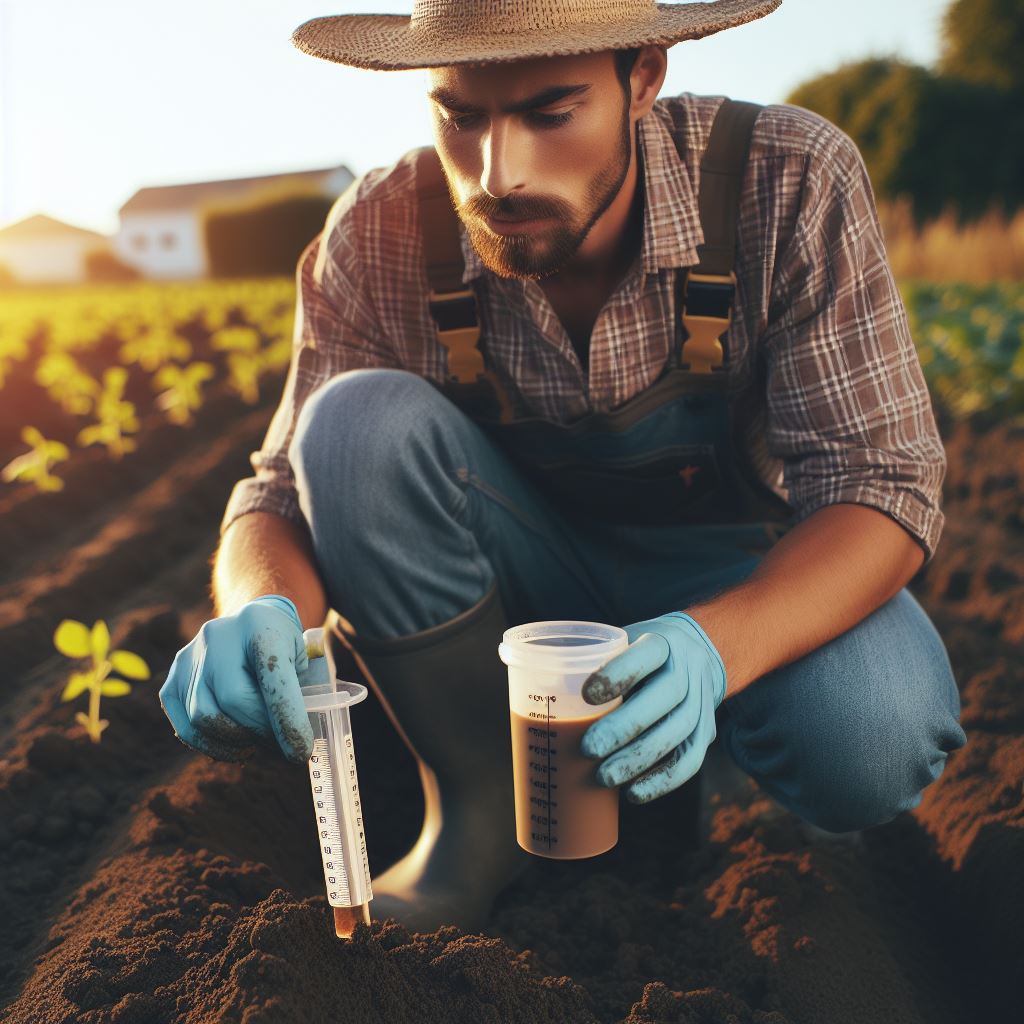Introduction
Importance of soil testing before planting
Soil testing is a crucial step before planting as it provides valuable information about the soil’s nutrient levels, pH balance, and potential contaminants.
By analyzing the soil, farmers and gardeners can make informed decisions about fertilizers and amendments, leading to healthier and more productive crops.
Purpose of the blog post
The purpose of this blog post is to highlight the significance of soil testing before planting. It aims to educate readers on the benefits of soil testing and provide tips on how to conduct a soil test effectively.
By understanding the importance of soil testing, readers can improve their gardening and farming practices and ultimately achieve better results.
Understanding Soil Testing
Definition of soil testing
- Soil testing is the process of analyzing the composition and characteristics of soil.
- It involves collecting samples from different areas of the land and conducting various tests.
- The aim is to assess soil fertility, nutrient content, pH level, and other factors that can affect plant growth.
Benefits of soil testing
- Soil testing helps in determining the specific needs of the soil and plants.
- It provides information about nutrient deficiencies, excesses, or imbalances in the soil.
- With this knowledge, farmers can make informed decisions regarding fertilizers and soil amendments.
- It promotes efficient use of resources, prevents overuse or underuse of fertilizers.
- Soil testing also helps in identifying potential soil contaminants that can affect crop quality and safety.
Factors influencing soil fertility and health
- Soil texture: The proportion of sand, silt, and clay particles affects nutrient and water holding capacity.
- Soil structure: The arrangement of soil particles determines aeration, drainage, and root penetration.
- Soil pH: It influences nutrient availability to plants, with different crops having varied pH preferences.
- Organic matter content: Organic matter improves soil structure, water retention, and nutrient availability.
- Nutrient levels: Adequate levels of essential nutrients (nitrogen, phosphorus, potassium, etc.) are crucial for plant growth.
- Microbial activity: Beneficial microorganisms in the soil contribute to nutrient cycling and disease suppression.
- Water availability: Proper moisture levels ensure optimal plant growth and nutrient uptake.
- Climate and weather: Temperature, rainfall, and sunlight affect microbial activity and nutrient availability.
In essence, soil testing is a vital step in ensuring successful plant growth. It allows farmers and gardeners to understand the specific needs of their soil, and make informed decisions regarding fertilizers, amendments, and plant selection.
By analyzing factors such as soil texture, structure, pH, nutrient levels, and microbial activity, they can optimize soil fertility and health. This leads to improved crop yield, reduced environmental impact, and better resource management.
Embracing soil testing practices is essential for sustainable agriculture and gardening.
Preparing for Soil Testing
Gathering necessary tools and materials
- Assemble the required tools and materials for soil testing, such as a soil probe, shovel, and plastic bags.
- Ensure you have a clean container to store the soil samples and labels to identify each sample accurately.
- Purchase a soil testing kit or contact a local agricultural extension office to obtain testing supplies.
- It is important to have access to clean water for washing tools and in case samples need to be moisturized.
Selecting sampling locations
- Identify the different areas in your land that require soil testing by zoning them based on similar characteristics.
- Consider factors like soil type, slope, drainage, and vegetation when selecting sampling locations.
- Aim to cover the entire area under consideration by sampling from both productive and non-productive areas.
- Make sure to sample separately areas that have been recently amended or treated with fertilizers or chemicals.
Sample collection techniques
- Prioritize collecting samples when the soil is slightly moist and not too dry or wet for accurate results.
- Use a soil probe or shovel to collect samples from the desired depth of the root zone.
- Collect multiple sub-samples from each sampling location to account for soil variability.
- Mix the sub-samples thoroughly in a clean container to create a composite sample representative of the area.
Taking representative soil samples
- Fill a clean plastic bag or container with approximately 1 to 2 cups of the composite soil sample.
- Label the bag or container with a unique identifier corresponding to the selected location.
- Seal the bag or container tightly to prevent any moisture or air from entering or escaping.
- Store all samples in a cool and dark place until they can be delivered to the testing laboratory.
In fact, preparing for soil testing involves gathering the necessary tools and materials, selecting sampling locations, employing proper sample collection techniques, and ensuring representative soil samples are obtained.
It is important to follow these steps diligently to obtain accurate results that will guide your soil management decisions.
Soil Testing Methods
Traditional laboratory testing
1. Soil sample submission process
- The process of submitting soil samples to a laboratory requires careful collection of representative samples and completing relevant forms.
- Samples are carefully extracted, labeled, and sealed to prevent contamination. Submission forms detailing sample origin, purpose, and specific testing requirements accompany the samples.
- Laboratories conduct various types of tests, such as pH level, nutrient analysis, and soil texture assessment.
2. Types of Tests Conducted in a Laboratory
- Physical Tests: Texture analysis moisture content determinationBulk density measurement
- Chemical Tests: pH measurement Nutrient analysis (NPK)Cation exchange capacity (CEC) determination.
- Biological Tests: Microbial activity assessment, Soil respiration measurement, Presence of specific organisms (e.g., nematodes) detection.
On-site soil testing kits
1. Advantages and limitations
Advantages
On-site soil testing kits offer the advantage of providing results right away and can be used directly on-site.
- Instant Results: Provides quick on-the-spot analysis.
- Cost-Effective: Reduces the need for laboratory testing expenses.
- Field Accessibility: Enables testing in remote or field locations.
- Real-time Decision Making: Immediate data for informed actions.
- User-Friendly: Simplified procedures suitable for non-experts.
Limitations
However, these kits have certain limitations in terms of the scope of tests they can perform.
- Accuracy: May not match lab precision.
- Limited Parameters: Some kits focus on specific soil aspects.
- Skill Dependence: Results influenced by user expertise.
- Single-use: Most kits provide one-time use only.
2. Types of tests possible with on-site kits
On-site testing kits offer various types of rapid diagnostic tests suitable for different purposes. Common tests include antigen tests, detecting specific proteins from the virus, providing quick results within minutes.
Molecular tests like Polymerase Chain Reaction (PCR) kits can detect the genetic material of the virus with high accuracy.
Antibody tests identify past infection by detecting antibodies produced by the immune system. Additionally, some kits offer multi-panel tests, capable of detecting various pathogens simultaneously.
These on-site kits are convenient for point-of-care testing in various settings such as clinics, workplaces, or community events, aiding in prompt decision-making and containment efforts.
Transform Your Agribusiness
Unlock your farm's potential with expert advice tailored to your needs. Get actionable steps that drive real results.
Get StartedRead: Pest Control in Sustainable Farming

Interpreting Soil Test Results
Soil testing before planting plays a crucial role in maximizing crop productivity and ensuring sustainable agriculture practices. Once you receive your soil test report, understanding and interpreting the results become essential.
In this section, we will discuss the process of interpreting soil test results and their significance in informing crop management decisions.
Understanding soil test report format
A soil test report usually follows a standardized format that provides valuable insights into the soil’s characteristics.
It typically includes information about various parameters analyzed, such as pH levels, nutrient levels (N, P, K), organic matter content, and soil texture/structure.
The report format may vary depending on the laboratory, but it’s essential to familiarize yourself with the terminology and presentation style to make informed decisions.
Key parameters and their significance
- pH levels: pH levels measure the soil’s acidity or alkalinity. The pH scale ranges from 0 to 14, with 7 being neutral. Different crops have specific pH requirements, and soil pH affects nutrient availability and microbial activity.
- Nutrient levels (N, P, K): Nitrogen (N), phosphorus (P), and potassium (K) are essential macronutrients for plants. Soil tests determine their concentrations, enabling effective fertilizer application to meet crop demands.
- Organic matter content: Organic matter influences soil fertility, water-holding capacity, and nutrient availability. It also promotes beneficial microbial activity and improves overall soil health.
- Soil texture and structure: Soil texture refers to the particle size distribution (e.g., sandy, loamy, clayey), while structure refers to the arrangement of soil particles. Texture and structure affect water infiltration, root penetration, and the success of soil management practices.
Understanding these key parameters helps identify areas of improvement and guides decisions on nutrition management, irrigation, and soil amendment practices.
Correlating test results with crop requirements
Interpreting soil test results requires relating them to the specific requirements of the intended crops. Different crops have varying nutrient preferences and pH preferences.
By understanding a crop’s nutrient and pH needs, soil test results enable growers to identify potential deficiencies or excesses.
Adjusting fertilizer application rates, selecting appropriate amendments, and managing soil health based on crop requirements ensure optimal plant nutrition and increased productivity.
In fact, interpreting soil test results is crucial for effective crop management. Understanding the soil test report format, key parameters, and their significance allows growers to make informed decisions regarding fertilizer application, soil amendments, and overall soil health management.
By aligning test results with crop requirements, farmers can maximize productivity, reduce nutrient losses, and promote sustainable agriculture practices.
Read: Diverse Crops for Healthier Soil
Adjusting Soil Conditions Based on Test Results
Soil amendments and their purpose
- Soil amendments are materials added to improve soil quality and provide essential nutrients.
- Compost, organic matter, and peat moss can enhance soil structure and water retention.
- Gypsum is used to reduce the level of clay in heavy soils and improve drainage.
- Sand can be added to improve soil drainage in areas with poor drainage.
- Manure is a good source of organic matter and nutrients for the soil.
Choosing appropriate fertilizers
- Understanding the nutrient requirements of plants is essential in choosing the appropriate fertilizers.
- Nitrogen, phosphorus, and potassium are the primary nutrients needed by plants.
- A soil test can determine specific nutrient deficiencies and guide fertilizer selection.
- Slow-release fertilizers are best for long-term plant growth and nutrient availability.
- Organic fertilizers, such as compost and manure, improve soil health and provide slow-release nutrients.
pH adjustments and lime requirements
- pH levels affect nutrient availability to plants.
- A soil test can determine the pH level, and lime can be added to adjust it.
- Most plants prefer a slightly acidic to neutral pH level between 6 and 7.
- Adding lime can raise the pH of acidic soils, making them more alkaline.
- Sulfur can be used to lower the pH of alkaline soils.
Correcting nutrient deficiencies or imbalances
- A soil test can identify nutrient deficiencies or imbalances in the soil.
- Specific fertilizers or soil amendments can be used to address these issues.
- For example, if a soil test reveals a nitrogen deficiency, a nitrogen-based fertilizer can be applied.
- If there is an imbalance in nutrients, such as excessive phosphorus, adjusting the fertilizer application can help.
- Regular soil testing can help prevent nutrient deficiencies and imbalances, ensuring optimal plant growth.
Read: Integrated Pest Management for Crops
Gain More Insights: Weed-Free Farming: Effective Strategies
Soil Test Frequency
Recommended frequency of soil testing
- Soil testing should ideally be conducted every 3-5 years to monitor changes.
- However, specific crops and regions may have different recommendations, so consult local authorities.
- Frequent testing may be necessary for fields with high nutrient demand or where soil conditions change rapidly.
- Regular testing ensures adjustments can be made to maintain optimal soil nutrient levels.
Factors Influencing Soil Test Intervals
- Historical data – Knowing previous soil test results helps determine testing frequency.
- Crop rotation – Different crops have varying nutrient requirements, affecting soil test intervals.
- Fertilizer and amendments – Frequent use may require more frequent testing to gauge their effectiveness.
- Environmental factors – Soil erosion, rainfall patterns, and temperature fluctuations impact testing intervals.
Benefits of regular soil testing
- Nutrient optimization – Soil tests reveal nutrient deficiencies or excesses, enabling precise fertilizer applications.
- Cost savings – Testing prevents unnecessary fertilizer purchases and reduces waste.
- Environmental protection – Avoiding excessive fertilizer use minimizes the risk of nutrient runoff into water bodies.
- Crop health improvement – Identifying potential issues through soil tests allows for timely corrective measures.
- Increased yields – Ensuring proper soil nutrient levels boosts crop productivity and profitability.
- pH balance maintenance – Regular tests monitor soil pH, helping avoid imbalances that hinder nutrient availability.
- Sustainable agriculture – Soil testing is a sustainable practice that promotes efficient resource management.
In all, soil testing is a crucial step in maximizing crop productivity and maintaining sustainable agriculture practices.
The recommended frequency, influenced by factors like historical data, crop rotation, and environmental conditions, should be followed to ensure accurate and actionable results.
Regular soil testing offers benefits such as optimized nutrient levels, cost savings, environmental protection, improved crop health, increased yields, and pH balance maintenance.
By conducting regular soil tests, farmers can make informed decisions regarding nutrient management, leading to long-term agricultural sustainability.
Read: Soil Testing: Key to Effective Fertilization
Find Out More: Crop Disease Control: Organic Solutions
Conclusion
Recap of the importance of soil testing before planting
Soil testing before planting is crucial for ensuring healthy plant growth, optimal nutrient availability, and disease prevention.
This process allows farmers and gardeners to understand the specific needs of their soil and make appropriate adjustments.
Regular soil testing provides valuable information on pH levels, nutrient deficiencies, and soil composition, enabling growers to make informed decisions.
Showcase Your Farming Business
Publish your professional farming services profile on our blog for a one-time fee of $200 and reach a dedicated audience of farmers and agribusiness owners.
Publish Your ProfileEncouragement to take necessary steps for soil testing
If you want to maximize crop yield and ensure the success of your planting efforts, soil testing is essential.
Investing in soil testing can save you time and money in the long run by preventing crop failure and reducing the need for excessive fertilization.
Remember, a healthy soil ecosystem is the foundation for productive and sustainable agriculture.
Final thoughts on optimizing crop yield through soil health
By prioritizing soil health, you can optimize crop yield, increase the nutritional value of harvested produce, and decrease environmental impact.
Implementing sustainable soil management practices, such as crop rotation, cover cropping, and organic amendments, can further enhance soil health.
Take the necessary steps to assess and improve your soil before planting to ensure long-term agricultural success.
Remember, healthy soil means healthy plants, healthy harvests, and a healthier planet.




